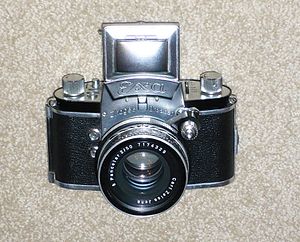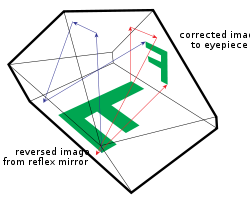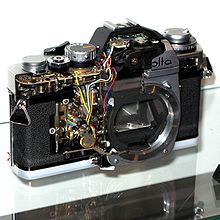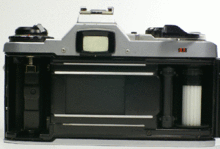Single-lens reflex camera
This article has multiple issues. Please help improve it or discuss these issues on the talk page. (Learn how and when to remove these template messages)
|


A single-lens reflex camera (SLR) is a
History

Until the development of SLR, all cameras with viewfinders had two optical light paths: one through the lens to the film, and another positioned above (TLR or twin-lens reflex) or to the side (rangefinder). Because the viewfinder and the film lens cannot share the same optical path, the viewing lens is aimed to intersect with the film lens at a fixed point somewhere in front of the camera. This is not problematic for pictures taken at a middle or longer distance, but parallax causes framing errors in close-up shots. Moreover, it is not easy to focus the lens of a fast reflex camera when it is opened to wider apertures (such as in low light or while using low-speed film).
Most SLR cameras permit upright and laterally correct viewing through use of a roof pentaprism situated in the optical path between the reflex mirror and viewfinder. Light, which comes both horizontally and vertically inverted after passing through the lens, is reflected upwards by the reflex mirror, into the pentaprism where it is reflected several times to correct the inversions caused by the lens, and align the image with the viewfinder. When the shutter is released, the mirror moves out of the light path, and the light shines directly onto the film (or in the case of a DSLR, the CCD or CMOS imaging sensor). Exceptions to the moving mirror system include the Canon Pellix and Sony SLT cameras, along with several special-purpose high-speed cameras (such as the Canon EOS-1N RS), whose mirror was a fixed beamsplitting pellicle.
Focus can be adjusted manually by the photographer or automatically by an autofocus system. The viewfinder can include a matte focusing screen located just above the mirror system to diffuse the light. This permits accurate viewing, composing and focusing, especially useful with interchangeable lenses.
Up until the 1990s, SLR was the most advanced photographic preview system available, but the recent development and refinement of digital imaging technology with an on-camera live LCD preview screen has overshadowed SLR's popularity. Nearly all inexpensive compact digital cameras now include an LCD preview screen allowing the photographer to see what the CCD is capturing. However, SLR is still popular in high-end and professional cameras because they are system cameras with interchangeable parts, allowing customization. They also have far less shutter lag, allowing photographs to be timed more precisely. Also the pixel resolution, contrast ratio, refresh rate, and color gamut of an LCD preview screen cannot compete with the clarity and shadow detail of a direct-viewed optical SLR viewfinder.
The first commercially produced SLR that employed a roof pentaprism was the Italian Rectaflex A.1000, shown in full working condition on Milan fair April 1948 and produced from September the same year, thus being on the market one year before the east German Zeiss Ikon VEB Contax S, announced on May 20, 1949, produced from September.
The Japanese adopted and further developed the SLR. In 1952,
, and Pentamatic, respectively).Digital SLRs
Canon, Nikon and
Contax came out with a DSLR model, the Contax N-Digital. This model was too late and too expensive to be competitive with other camera manufacturers. The Contax N-digital was the last Contax to use that maker's lens system, and the camera, while having impressive features such as a full-frame sensor, was expensive and lacked sufficient write-speed to the memory card for it to be seriously considered by some professional photographers.
The digital single-lens reflex camera have largely replaced film SLRs design in convenience, sales and popularity at the start of the 21st century.
Optical components


A cross-section (or 'side-view') of the optical components of a typical SLR camera shows how the light passes through the lens assembly, is reflected by the mirror placed at a 45-degree angle, and is projected on the matte focusing screen. Via a condensing lens and internal reflections in the roof pentaprism the image appears in the eyepiece. When an image is taken, the mirror moves upwards from its resting position in the direction of the arrow, the focal plane shutter opens, and the image is projected onto the film or sensor in exactly the same manner as on the focusing screen.
This feature distinguishes SLRs from other cameras as the photographer sees the image composed exactly as it will be captured on the film or sensor.

Most 35 mm SLRs use a roof
Another prism design was the porro prism system used in the Olympus Pen F, the Pen FT, the Pen FV half-frame 35 mm SLR cameras. This was later used on the Olympus EVOLT E-3x0 series, the Leica Digilux 3 and the Panasonic DMC-L1.
A right-angle finder is available that slips onto the eyepiece of most SLRs and D-SLRs and allows viewing through a waist-level viewfinder. There is also a finder that provides EVF remote capability.
Shutter mechanisms
Almost all contemporary SLRs use a
Other focal-plane shutter designs, such as the
Another shutter system is the
Further developments

Since the technology became widespread in the 1970s, SLRs have become the main photographic instrument used by dedicated amateur photographers and professionals. Some photographers of static subjects (such as architecture, landscape, and some commercial subjects), however, prefer
Film formats
Early SLRs were built for
A small number of SLRs were built for APS such as the Canon IX series and the Nikon Pronea cameras. SLRs were also introduced for film formats as small as Kodak's 110, such as the Pentax Auto 110, which had interchangeable lenses.

The
Common features


Other features found on many SLR cameras include through-the-lens (TTL) metering and sophisticated flash control referred to as "dedicated electronic flash". In a dedicated system, once the dedicated electronic flash is inserted into the camera's hot shoe and turned on, there is then communication between camera and flash. The camera's synchronization speed is set, along with the aperture. Many camera models measure the light that reflects off of the film plane, which controls the flash duration of the electronic flash. This is denoted TTL flash metering.
Some electronic flash units can send out several short bursts of light to aid the autofocus system or for wireless communication with off-camera flash units. A pre-flash is often used to determine the amount of light that is reflected from the subject, which sets the duration of the main flash at time of exposure. Some cameras also employ automatic fill-flash, where the flash light and the available light are balanced. While these capabilities are not unique to the SLR, manufacturers included them early on in the top models, whereas the best rangefinder cameras adopted such features later.
Design considerations
Many of the advantages of SLR cameras derive from viewing and focusing the image through the attached lens. Most other types of cameras do not have this function; subjects are seen through a viewfinder that is near the lens, making the photographer's view different from that of the lens. SLR cameras provide photographers with precision; they provide a viewing image that will be exposed onto the negative exactly as it is seen through the lens. There is no
Compared to most fixed-lens compact cameras, the most commonly used and inexpensive SLR lenses offer a wider aperture range and larger maximum aperture (typically f/1.4 to f/1.8 for a 50 mm lens). This allows photographs to be taken in lower light conditions without flash, and allows a narrower depth of field, which is useful for blurring the background behind the subject, making the subject more prominent. "Fast" lenses are commonly used in theater photography, portrait photography, surveillance photography, and all other photography requiring a large maximum aperture.
The variety of lenses also allows for the camera to be used and adapted in many different situations. This provides the photographer with considerably more control (i.e., how the image is viewed and framed) than would be the case with a view camera. In addition, some SLR lenses are manufactured with extremely long focal lengths, allowing a photographer to be a considerable distance away from the subject and yet still expose a sharp, focused image. This is particularly useful if the subject includes dangerous animals (e.g., wildlife); the subject prefers anonymity to being photographed; or else, the photographer's presence is unwanted (e.g., celebrity photography or surveillance photography). Practically all SLR and DSLR camera bodies can also be attached to telescopes and microscopes via an adapter tube to further enhance their imaging capabilities.

In most cases, single-lens reflex cameras cannot be made as small or as light as other camera designs—such as
The SLR mirror 'blacks-out' the viewfinder image during the exposure. In addition, the movement of the reflex mirror takes time, limiting the maximum shooting speed. The mirror system can also cause noise and vibration. Partially reflective (pellicle) fixed mirrors avoid these problems and have been used in a very few designs including the
SLRs vary widely in their construction and typically have bodies made of plastic or magnesium. Most manufacturers do not cite durability specifications, but some report shutter life expectancies for professional models. For instance, the Canon EOS 1Ds MkII is rated for 200,000 shutter cycles and the Nikon D3 is rated for 300,000 with its exotic carbon fiber/kevlar shutter. Because many SLRs have interchangeable lenses, there is a tendency for dust, sand and dirt to get into the main body of the camera through the mirror box when the lens is removed, thus dirtying or even jamming the mirror movement mechanism or the shutter curtain mechanism itself. In addition, these particles can also jam or otherwise hinder the focusing feature of a lens if they enter into the focusing helicoid. The problem of sensor cleaning has been somewhat reduced in
The price of SLRs in general also tends to be somewhat higher than that of other types of cameras, owing to their internal complexity. This is compounded by the expense of additional components, such as flashes or lenses. The initial investment in equipment can be prohibitive enough to keep some casual photographers away from SLRs, although the market for used SLRs has become larger particularly as photographers migrate to digital systems.
Future
The digital single-lens reflex camera has largely replaced the film SLR for its convenience, sales, and popularity at the start of the 21st century. These cameras were the marketing favorite among advanced amateur and professional photographers through the first two decades of the 2000s. Around 2010, the mirrorless technology utilized in point and shoot cameras made the way to the interchangeable lens cameras and slowly replaced DSLR technology.
As of 2022, all the major camera brands (Except Pentax) ceased development and production of DSLRs and moved on to mirrorless systems. These systems offer multiple advantages to the photographer with regards to autofocus systems as well as the ability to update the lens technologies due to the reduced distance between the back of the lens and the sensor resulting from the removal of the mirror.
Film-based SLRs are still used by a niche market of enthusiasts and format lovers.[6]
See also
References
- ^ One was patented in 1861 (Thomas Sutton), but it is not clear if a second example was ever produced; Calvin Rae Smith's design of a Patent Monocular Duplex camera was advertised and sold. Spira, The History of Photography, 119.
- ^ A. O. Gelgar's Sport
- ISBN 978-1-118-97183-3.
- ^ "Article at Photopedia". Bichkov.com. 2008-01-23. Retrieved 2013-10-15.
- ^ Tal, Guy. "Introduction to Large Format". Nature Photographers Online Magazine. Retrieved 2007-08-28.
- ^ "ARRI, Panavision, and Aaton Cease Production of Film Cameras; Will Focus Exclusively on Digital". Collider. 12 October 2011.
Further reading
- Spira, S. F. The History of Photography as Seen through the Spira Collection. New York: Aperture, 2001. ISBN 0-89381-953-0.
- Antonetto, Marco: "Rectaflex – The Magic Reflex". Nassa Watch Gallery, 2002. ISBN 88-87161-01-1
External links
- Photography in Malaysia's Contax History, Part II.
- 'Innovative Cameras' by Massimo Bertacchi
- Rolleiflex SL 66 (Rolleiflex SL 66 Medium Format Single Lens Reflex camera).
